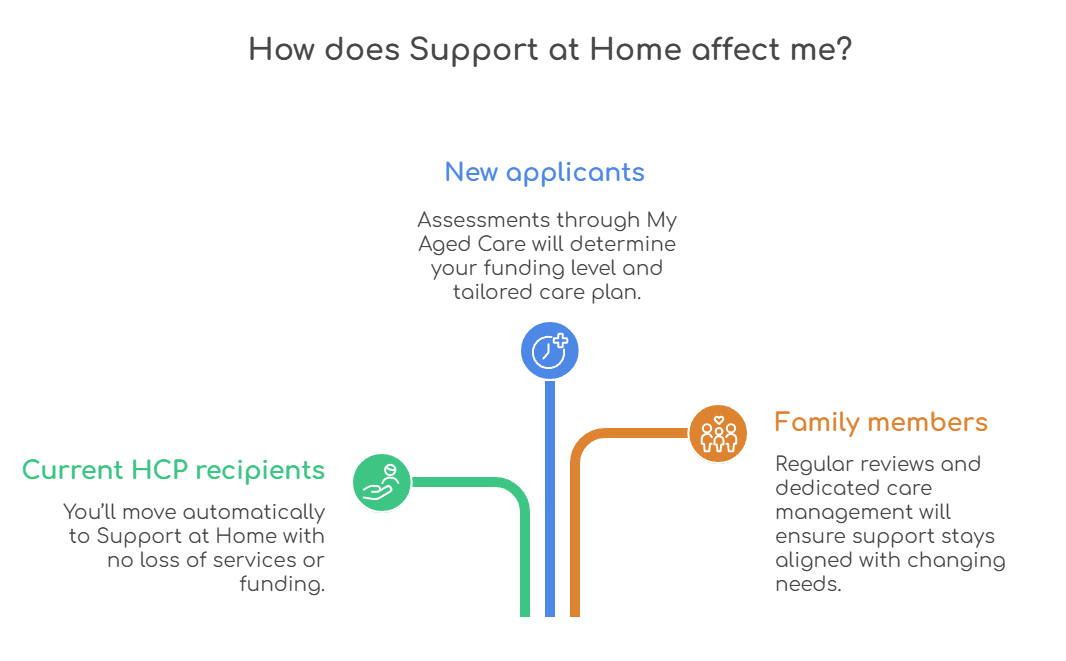The Support at Home program 2025 - The next stage of aged care
Support at Home starts 1 November 2025, replacing Home Care Packages. Learn what's changing in aged care, new funding levels, and how it affects you.
Author: Sensible Care

The Support at Home program is a major update to Australia's aged care system, launching on 1 November 2025. It introduces eight funding levels and quarterly reviews, ensuring care can adjust as people's needs change. The new program will include automatic transitions for current recipients and clearer pricing rules to come. It focuses on giving older Australians greater control and confidence to stay safe and independent at home.
Australia's aged care system is entering a new era with the launch of the Support at Home program in November 2025.
This Home Care Package reform will reshape how in-home care is delivered, with more choice, stronger clinical focus, and simpler ways to manage support.
This article breaks down what this change means for older Australians, families, and carers.
You'll learn how the new funding levels and quarterly reviews work, what services are included, and how current care recipients will transition automatically.
We'll also show you how Sensible Care will help you prepare for the change easily and confidently.
Key takeaways
- Start date: 1 November 2025 (nationwide)
- What it replaces: Home Care Packages and Short-Term Restorative Care (and the Commonwealth Home Support Program from July 2027)
- Who it's for: Older Australians who need help to live at home — aged 65+ (50+ for Aboriginal and Torres Strait Islander people)
- Existing recipients: They will automatically move to Support at Home with no loss of funding or services
- What's new: eight funding levels, quarterly budgets and reviews, stronger clinical support, clearer pricing and capped fees, and 10% of each budget will be reserved for care management
What will change in 2025?
From 1 November 2025, Australia's aged care system will undergo one of its biggest updates in years. The Support at Home program is a new program for in-home aged care, which will replace Home Care Packages (HCP).
This change will bring a more flexible and transparent way to deliver care at home. These changes will apply to:
- Structure and budgets
- Services and clinical support
- Care planning and management
- Costs, pricing, and consumer protections

You will be able to access your support faster, manage your budget better, and align your care with needs more closely.
Structure and budgets
Under the new model, the government will introduce eight funding levels instead of the current four used in the HCP system.
This means your care plan and budget will be better matched to your level of need. This applies to those who need minimal help with daily tasks or intensive ongoing clinical care.
Each funding level comes with a set annual budget. Budgets will now roll out quarterly, with reviews every three months. These regular check-ins ensure your care plan continues to suit your circumstances and that your funding is being used effectively.
Unspent funds can still roll over, but the new rules will tighten how long money can sit unused. This will encourage people to make the most of their support rather than saving it indefinitely.
Services and clinical supports
The new Support at Home program covers a broad range of in-home services, building on what was previously available through Home Care Packages.
Funded supports will include:
- Personal care (help with showering, dressing, or grooming)
- Domestic services (cleaning, laundry, and meal preparation)
- Transport (to appointments or community activities)
- Allied health (physiotherapy, podiatry, and occupational therapy)
- Nursing services
- Assistive technology (equipment like mobility aids, safety alarms, or modified utensils)
- Home modifications (ramps, handrails, or accessible bathrooms)
- Restorative and reablement services (short-term programs to improve independence)
- End-of-life care and palliative support

A major improvement is the stronger focus on clinical care.
Nursing and allied health services will be easier to access, and providers will have clearer guidelines for delivering them.
The program also invests more in early intervention and restorative care. This will support people to stay mobile, independent, and active in their homes for longer.
Details about services, capital item funding, and assistive technology costs will be finalised when the program and its official fee schedules are released.
Care planning and management
Every participant in Support at Home will be supported by a Care Partner. This will be someone who helps plan, coordinate, and manage care.
This replaces much of the current administrative complexity of HCP providers.
Around 10% of each person's budget will automatically go to care management. This ensures ongoing oversight and regular updates to your care plan, helping to adjust supports quickly when your needs change.
Assessments will continue to be carried out through My Aged Care.
We will also see new assessment tools that give a more complete picture of a person's health, abilities, and medical requirements.
Costs, pricing, and consumer protections
Government subsidies will remain a central part of the Support at Home program.
However, as with current systems, individuals may still contribute to the cost of their care depending on income and the services they use.
One of the biggest consumer reforms is the introduction of price caps and clearer fee rules, starting on 1 July 2026.
This means that providers can no longer set widely varying fees for similar services. These caps will make pricing fairer and easier to compare.
The government has also confirmed a lifetime cap on income-tested fees. This is a legal safeguard ensuring that no one pays more than a set total amount for their care throughout their lifetime.
These measures aim to make aged care pricing more transparent and predictable. They will reduce unexpected costs for older Australians and their families.
Transition of other programs
Home Care Packages and the Short-Term Restorative Care program will end in November 2025.
The Commonwealth Home Support Programme (CHSP) will continue for now. The government has announced that CHSP will stay in place until July 2027, but not earlier than that.
Work is already underway to plan how CHSP will eventually merge with Support at Home.
This will happen gradually to ensure that people receiving low-level support are not disrupted and that providers have time to adjust.
What this means for you
The Support at Home program will bring significant changes for older Australians, their families, and their care providers.
Here's what to expect depending on your situation.

If you're a current Home Care Package (HCP) recipient
You don't need to reapply or fill out any new paperwork. Your current care and funding will automatically transfer to the Support at Home program when it begins.
Your care provider will contact you directly before the transition to explain how your current services will fit into the new model.
You'll keep receiving the same services, such as home cleaning, personal care, or nursing visits. However, these services now fall under a simpler and more flexible funding system.
Your care budget and services will stay the same, and you won't lose any existing entitlements.
Over time, your provider may suggest updates to your plan to take advantage of the new features. These include quarterly reviews, equipment options, and added allied health support.
With this change, your care will continue without interruption, offering you lower costs, better medical aid, and improved organisation.
If you want to apply for the first time
New applicants will enter the system directly through My Aged Care, which remains the national entry point for aged care services.
Once you register, you'll go through an updated assessment process. This new system will better understand your health, lifestyle, home environment, and support needs.
Based on that assessment, you'll be assigned one of the eight new funding levels.
You and your Support Partner will develop your care plan together. They will also help you decide how to use your budget.
Budgets go under review every three months to make sure they still meet your needs. This means you'll have more tailored support and a clearer sense of how your funding is being used from the start.
If you're a family member or carer
Families and carers will also benefit from the changes.
With quarterly reviews built into every care plan, you'll see a more structured approach to monitoring your loved one's wellbeing.
The dedicated care management portion of each budget (around 10%) means there will always be someone keeping an eye on how things are going.
This includes:
- Coordinating appointments
- Arranging new services
- Ensuring your loved one's care remains consistent and safe
Care managers can quickly change plans if your needs change. You can always talk to them about updates to your health, daily life, or housing.
This new approach also means:
- Fewer administrative hassles
- More transparency
- Better communication between families, providers, and health professionals
Practical examples of support
The Support at Home program will adapt as your needs change, offering flexible, clinically supported care that grows with you.
Here's a common example showing how the new system works in practice:
George, aged 85, lives with multiple chronic conditions, including diabetes and a heart condition.
He requires regular nursing care and daily help managing his medications. He's assessed under the highest Support at Home funding level.
His plan includes:
- Regular home visits from a community nurse for wound care and medication management
- Allied health services such as dietitian support and podiatry to help manage his diabetes
- Assistive equipment, like a hospital-style adjustable bed and mobility aid
- Respite care for his wife, who is his primary carer
Because clinical care is now easier to access, George's nursing and allied health services are fully funded, with no out-of-pocket costs.
His Support Partner oversees coordination between the nurse, GP, and allied health team, ensuring all providers agree.
When George's health changes, the care plan can be updated quickly during the next quarterly review.
This system provides reliable care, which helps avoid going to the hospital and lowers stress for the family.
FAQ
Do I need to reapply if I already have a Home Care Package (HCP)?
No. If you currently receive a Home Care Package, you'll be automatically transferred to the Support at Home program on 1 November 2025. There's no need to reapply or change providers.
Will I lose my existing services or funding?
No, your funding level and services will remain the same when the new system begins. You'll continue receiving the same type of care, just under a new, simpler structure.
How will my care plan be managed?
You'll have a Support Partner who helps you create and manage your care plan, ensuring your services match your needs. Your plan will be reviewed every three months and updated when necessary.
When will price caps and new fee rules start?
Starting in 2027, the government will set price limits and require clear fees to guarantee everyone gets fair and standard prices from care providers.
How Sensible Care can help you transition to Support at Home
The upcoming Support at Home program marks a major shift in how aged care is delivered across Australia.
At Sensible Care, we're here to make that transition as easy and stress-free as possible.
Our experienced team understands how these changes affect you and your family, from funding levels and service options to care planning and clinical support.
We'll work with you to:
- Review your current care plan and explain how it fits under the new system
- Help you understand your funding level and entitlements
- Develop a personalised care plan that reflects your goals, health, and lifestyle
- Coordinate services and clinical care so everything runs smoothly when the new program begins
With Sensible Care by your side, you'll have the clarity and reassurance you need to make informed choices about your in-home care.
Get in touch with Sensible Care today to start preparing for the Support at Home program.
Take the Next Step in Care
Download our Info Kit or speak to one of our friendly team members today.
Need Help Getting Started?
Reach out on your terms, pick a time that suits you and let’s talk about how we can help.
.webp)
.svg)


.webp)